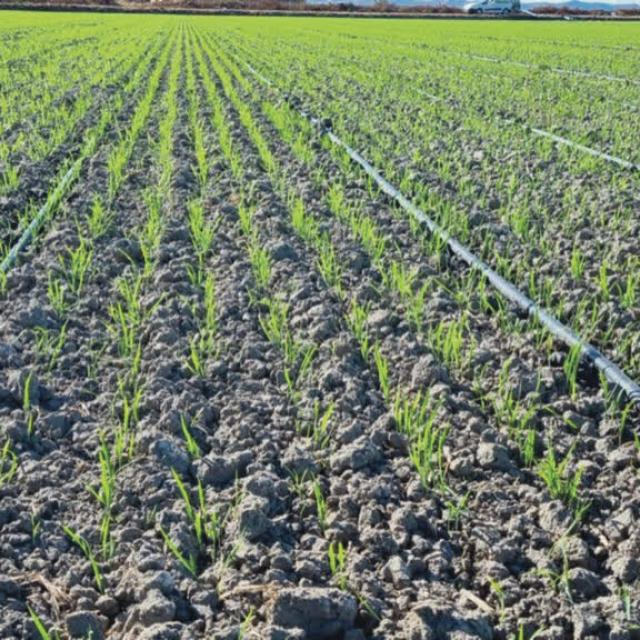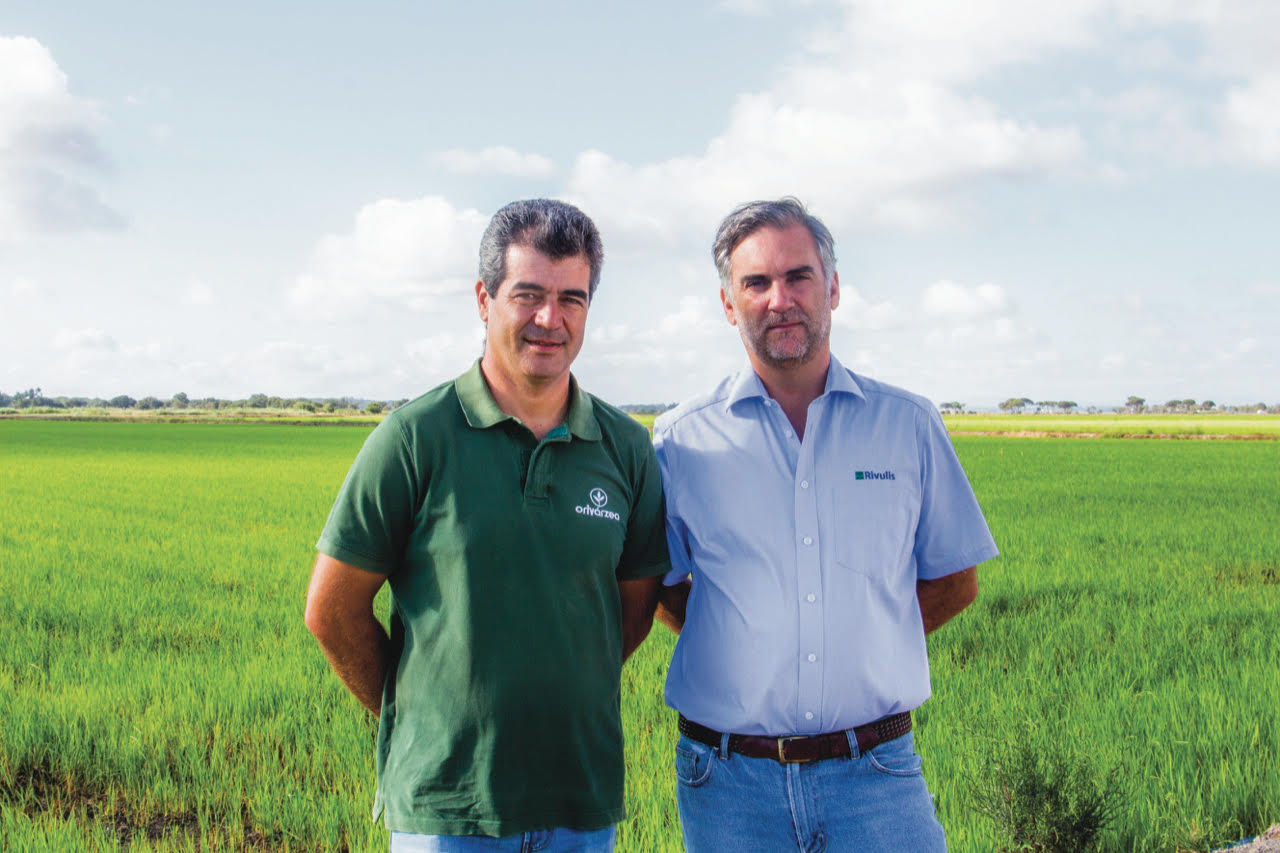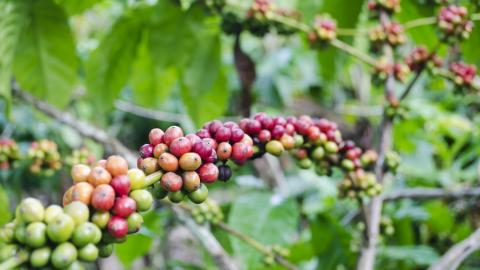Rice. Maybe the most common grain in the world. It can be found in almost every household on the planet. It is one of the major food sources in the world. It is a commodity! In the 2021–2022 season, about 520 million metric tonnes of rice were consumed worldwide.

The surface area of land used for rice cultivation worldwide is incredibly vast. In 2021 season, there were around 165.25 million hectares of rice being grown worldwide.
And almost all of that land is constantly being flooded.
Although rice paddies (growing rice in flooded fields) represent a traditional method of cultivation, it is not perfect and has significant drawbacks. These range from suboptimal growing conditions and pollution to greenhouse gas emissions.
However, the main disadvantage is undoubtedly its use of fresh water and with the help of climate change, this precious resource is becoming more and more scarce. 2022 was a very dry year in the Iberian Peninsula. Everyone was affected by it whether they knew about it or not. No-one can escape from this kind of drought.
Rice growers have definitely been aware of the situation and decrees were issued to reduce the surface area of rice grown.
“The autumn–winter estimates for cereal production for the 2022–2023 marketing campaign, for the 2022 harvest, generally reflect a decrease compared to the previous campaign. In spring cereals, the forecasts for the area under cultivation for the 2022 harvest show decreases in rice (-34.5%), maize/corn (-10.1%) and sorghum (- 3.8%).” Government of Spain, Ministry of Agriculrure, Fisheries and Food (source: Boletín Mensual de Estadística - Agosto-Septiembre 2022 - Ministerio de Agricultura, Pesca Y Alimentación)
The advantages of drip irrigation over flood irrigation
Drip irrigation has many advantages over flood irrigation and most of them are well known. We will highlight some of them here and see how using drip irrigation for rice might have certain advantages.
Efficient use of water. As demonstrated by the trial described below, huge amounts of water can be saved by using drip irrigation. It is safe to say that this is common knowledge. What is not so widely understood are the implications regarding the over-use of water in flood irrigation, specifically in rice paddies.
Damage to soil structure and compactization. Standing water has a strong influence on the soil beneath it. When the soil is at a constant saturation point, no ventilation is possible, permeability is compromised and the soil becomes anoxic.
All of these cause damage to the soil, the microorganisms present and the plants themselves.
Irrigating rice with drip irrigation allows the soil to maintain “field capacity”, or any other soil water content level desired by the grower, maintaining a healthy, maintaining a healthy well-ventilated soil with a suitably stable structure.
Efficient use of nutrients. Another well-known fact is that with flood irrigation the nutrients are not used efficiently. The fertilizers applied are leached downwards to a level below the root zone. Not being available to the plant, the fertilizers pollute the groundwater resources. This is almost unavoidable with flood irrigation.
Drip irrigation, on the other hand, offers the most efficient use of nutrients, which saves money. Not only is pollution cut to a minimum, the savings on fertilizer are maximized.
Greenhouse gas emissions. Now this might come as a surprise, but rice paddies are actually a major contributor to global warming via greenhouse gas (GHG) emissions. The anaerobic conditions caused by water-logged soils create the perfect environment for methanogenic bacteria. Biological decomposition of organic matter under these conditions produces and releases huge amounts of methane (CH4) into the atmosphere. Wetlands (natural and man-made) are the single largest source of atmospheric CH4 emissions, accounting for approximately 39–112 Tg CH4 yr1 from rice paddies. (source: Chen & Prinn, 2006; Denman et al., 2007).
This is a self-perpetuating situation. Rice paddies contribute to climate change, which in turn makes it harder for rice growers to grow rice as before. The use of drip irrigation, which allows the soil to be aerated, can reverse the trend, not only saving water and nutrients, but putting the brakes on one of the major contributors to global warming and climate change.
Other benefits – fertigation. For rice growers in Portugal, it is common to fertilize the fields from the air using small planes. Drip irrigation offers a wonderful alternative. Using the irrigation system not only for watering, but also for applying nutrients, has great benefits. Apart from the substantial savings made on the quantities used, fertigation allows for the nutrients to be applied directly to the relevant root zone at exactly the right time, for exactly the correct duration, by simply pushing a button, without the need for a plane.
The good news
Preliminary large-scale trial. Modern rice cultivation is the next step for drip irrigation. Rivulis has joined the collective effort of finding a way to make this work.
The Rivulis team in Portugal, together with our dealer Magos, which was in charge of logistics, labor, system components and others, have decided to take on this revolutionary challenge.

In collaboration with a Portuguese organization of rice farmers called Orivárzea S.A., a field trial was set up.
The partner. Orivárzea S.A. is a cooperative of rice growers from Ribatejo, Portugal, comprising 42 different farmers with a total of 3,850 hectares.
• Total production: 22,000 tonnes (i.e. 15% of the national production)
• Irrigation method: flooding by submersion
• Water consumption: 10.000–15.000 m3/ha
Rivulis undertook a drip irrigation trial with Oriváres S.S on one of their farms. Needless to say, this caused quite a “buzz”…
Initial aim. Before perfecting this method of rice cultivation, we first wanted to make sure that using drip irrigation for rice is possible. Saving on water and substantially improving the efficiency of water use for this crop were our main objectives.
The trial. We used T-Tape (708-30-250), flow rate 0.75 l/h, with 1 meter between laterals.
• Rice variety: Ariete (Japónic–Carolino)
• Date of seeding: 19 May
• Date of harvesting: 12th October
• Seeding density: 170 kg/ha (compared with the flooded plot, which had 200 kg/ha), 13.5 cm between rows of seeds
• Sowing depth: 3 cm
• Crop cycle: 130 days
Water conservation.
Although the yield was slightly lower than the national average, we managed to save 45% on total water use. This figure is important. A 45% decrease in water use shows that rice can indeed be cultivated with the use of drip irrigation. Fresh water might be the single most important resource we have. Being able to produce the same amount of food (if not more) with only half the amount of water is definitely a bonus, not only for Portugal and the Iberian Peninsula, but for the whole world.
Drip irrigation has been around for a while, but still a huge part of the food we consume is being produced with the use of flood irrigation. This breakthrough will allow us to conserve a great deal of water once it is adopted by rice growers.
Making a choice / Summary
Water is an extremely valuable resource – saving it might also require an investment. Installing a drip irrigation system and saving around 50% of the water needed for the proper cultivation of rice naturally has a price, in this case, an investment of 600 €/ha. Depending on the location, climatic conditions, soil type and other factors, this number can vary. Once a drought is upon us and governments decide to reduce the total area under flood irrigation, a 50% saving on water might result in twice the surface area being irrigated with the same amount of water.
This trial, although preliminary, represents a very promising first step. This concerns the whole world. The idea of reducing water use by 50% worldwide, saving on fertilizers and reducing pollution for international rice production is unbelievable. Cutting down on GHG emissions along the way is an unexpected bonus when using drip irrigation for rice.
Rivulis is dedicated to investing in innovations in the field to support rice growers world-wide

